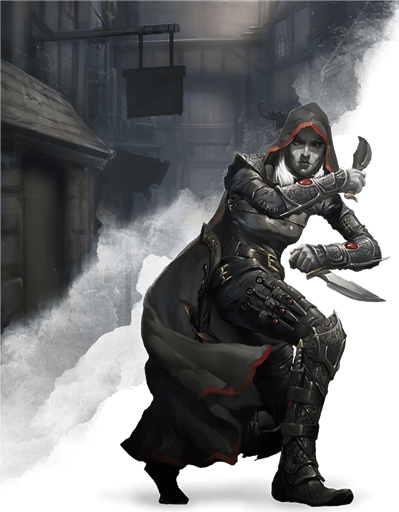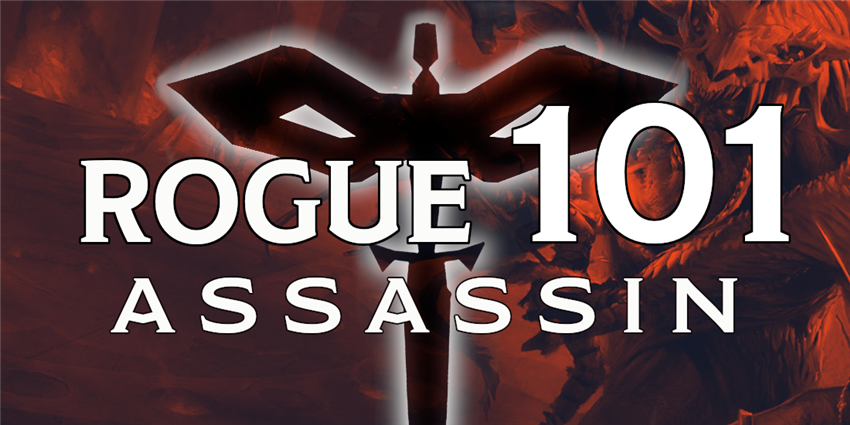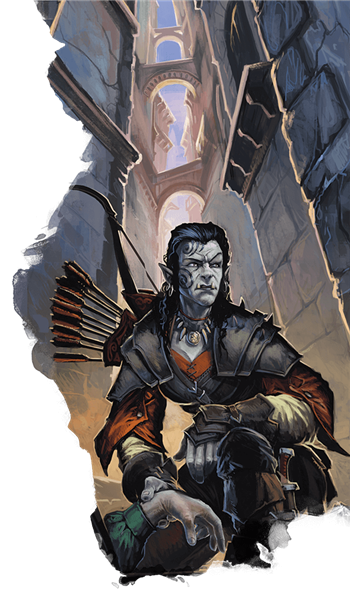 Class is back in session. This week, walk with silent footfalls and carry only weapons small enough to conceal until they appear mysteriously between our enemies’ ribs. Few mortal beings can deal as much damage in a single turn as a rogue who practices the art of assassination—but the act of killing with a single blow requires special preparation, and a DM who weaves scenarios where you can attack from surprise.
Class is back in session. This week, walk with silent footfalls and carry only weapons small enough to conceal until they appear mysteriously between our enemies’ ribs. Few mortal beings can deal as much damage in a single turn as a rogue who practices the art of assassination—but the act of killing with a single blow requires special preparation, and a DM who weaves scenarios where you can attack from surprise.
We’ve completed our first full rotation of the twelve classes, and exhausted all the content that the Basic Rules have to offer—as far as classes go, that is. This next wave of the Class 101 series will appraise every subclass within the Player’s Handbook and break down each subclass’s strengths, weaknesses, thematic elements, and everything else a player would want to know before playing that subclass. Because of this, you will need to own the Player’s Handbook (or purchase the subclass a la carte on the Marketplace) in order to make full use of this series.
Check out the other guides in the Class 101 series, like the broad overview of the rogue class in Rogue 101: A Beginner’s Guide to Stealth and Subterfuge, and Rogue 101: Thief. If you’re interested in playing other classes, check out the entire Class 101 series.
Story of the Assassin
An assassin waited upon a rooftop in a small farming village. She perched behind a chimney, staring at the windows of a small country inn. A harvest moon hung overhead, and the only sound in the air was that of a rusty vane creaking in the wind. After months of searching, weeks of disguises, and countless insufferable hours of favors and honeyed words, she had found him. Her eyes narrowed, and she peered into his window. The yellow glow of his room’s lamp filtered through his curtained window onto the snow. He’s not above the ground floor, she thought. Arrogant bastard.
Then the lamplight flickered out. The assassin smiled. She leapt from rooftop to rooftop, until she reached the inn her target was hiding in. She clambered quietly down the gutterpipe and set one foot deftly on his windowsill. No trace would be left in the snow beneath his room. Not a trace of her murder would be found—save the ultimate proof.
She opened the window. The room was silent. Less than a minute later, she left, and was never seen in that village again. The next day, the target never left his room. He had told the innkeeper that he was to remain undisturbed when he bought the room, and so no maid came to bother him. It wasn’t until the stench came wafting out a week later that someone dared enter. And by that time, the assassin was over a hundred miles away, never to be found.
Assassin Features
Rogues trained in the art of assassination are renowned for the ability to deal massive damage to unsuspecting foes—but that’s not the only trick they have up their sleeves. The rogue gains access to four subclass features, but many of them skew late. Though you gain access to the first at 3rd, you must wait until 9th for your next, with your final two features eventually coming at 13th and 17th level. You can read all of the Assassin features in the Player’s Handbook. In summary, your subclass features allow you to:
- Deliver lethal blows to unsuspecting enemies.
- Create a false identity to help you infiltrate your target’s defenses.
- Study another person’s behavior to mimic their mannerisms.
- Deliver even more deadly strikes to unsuspecting enemies.

Benefits of the Assassin Archetype
In terms of combat abilities, the assassin is an incredibly straightforward archetype: attack your enemies before they have the chance to attack you—especially if they don’t even know you’re there. Your best turn in combat will invariably be the first turn. After that, you act more or less exactly like any other rogue, unless there are other foes that you can try to surprise and assassinate before they’re aware that a fight’s broken out.
The Assassinate feature, which you gain at 3rd level, seems remarkably powerful on the surface. While it is legitimately powerful, it does have some confusing wording that can lead you to believe it’s more vicious than it actually is. This relates to its “automatic critical hit” effect, which doubles all dice in your attack—including Sneak Attack dice. An attack is only an automatic critical if the creature you’re attacking is surprised. This means that the creature CAN’T be aware of your presence, or that a fight is happening at all. Surprise only happens at the start of a combat encounter, and only when someone in combat is totally unaware of any of their attackers.
Beyond your combat abilities, the assassin gets a suite of social abilities that can give you total mastery in the art of disguise and deception. Your Infiltration Expertise and Imposter traits are both broad in scope, allowing you to fabricate false identities and even assume the identity of someone else. Beyond simply assuming someone’s appearance, like what a changeling might do, these traits allow you to believably mimic this person’s mannerisms and even their handwriting, allowing you to forge documents. These traits are incredibly powerful in an intrigue-focused campaign where words and letters are just as powerful as swords and spells.
Drawbacks of the Assassin Archetype
 The Assassin archetype’s greatest noncombat strength is, ironically, also its greatest weakness. The Infiltration Expertise and Imposter class features are potent in the right circumstances, but have precious little use outside of that particular niche. In campaigns with straightforward villains to whom intrigue isn’t important—that is, if your campaign is more Infinity War than James Bond—then this features won’t do you much good. Creative rogues may be able to squeeze some use out of them, but these features really rely on your Dungeon Master setting the stage for them to be useful.
The Assassin archetype’s greatest noncombat strength is, ironically, also its greatest weakness. The Infiltration Expertise and Imposter class features are potent in the right circumstances, but have precious little use outside of that particular niche. In campaigns with straightforward villains to whom intrigue isn’t important—that is, if your campaign is more Infinity War than James Bond—then this features won’t do you much good. Creative rogues may be able to squeeze some use out of them, but these features really rely on your Dungeon Master setting the stage for them to be useful.
You may be able to ask your DM to involve elements of intrigue that suit your subclass. Howeveryou’re your DM is unwilling to bend their campaign arc, or if you like assassinating enemies but just aren’t that interested in subterfuge, then you may want to multiclass. Rogues uninterested in making false identies often choose to multiclass after reaching 8th level in the rogue class, before they gain their 9th-level subclass feature. Good potential multiclassing options include fighter (both Champion and Battle Master are useful), monk (particularly if you want to follow the Way of Shadows), or—if you want to make a more unusual choice—cleric (following a domain like Knowledge or Trickery) or sorcerer (with the Shadow Magic bloodline from Xanathar’s Guide to Everything) can be exciting choices.
Suggested Build
Like most classes in D&D, the rogue doesn’t choose their subclass until 3rd level. If you’re playing a rogue from 1st level and think you want to become an Assassin later, you should choose a race that improves your Dexterity score. If you plan on creating false identities, then consider making Charisma your next-best feature. If you’re uninterested in subterfuge and would prefer assassinating monsters in dungeons, making either Intelligence (to improve your Investigation abilities) or Wisdom (to improve your Perception abilities) your second-highest ability score would be wise.
Wood elves, dark elves, and lightfoot halflings make excellent assassins, thanks to their bonuses to both Dexterity and Wisdom, and because they have racial traits that make it easy for them to hide in plain sight. Forest gnomes make surprisingly good assassins, thanks to their bonuses to both Dexterity and Intelligence, and their ability to cast minor illusion at will. Half-elves can be suave and charismatic assassins, and humans are flexible people who can adapt to just about any calling—especially if you play a variant human with the Skulker feat.
As usual, your character’s background is up to you. You can come up with all sorts of interesting stories and oddball characters by pairing unlikely backgrounds with the Assassin archetype. Are you a personable and charming assassin, who prefers to observe opponents over a game of Three-Dragon Ante while sipping a shaken-not-stirred martini? The Folk Hero or Charlatan backgrounds would serve you well. Or are you a silent and stoic killer, bred by war or wilderness? The Soldier or Outlander backgrounds might fit you.
It’s a safe bet to choose EQUIPMENT when given the choice between GOLD or EQUIPMENT during character creation. As long as you have a weapon with the Finesse trait (such as a rapier, short sword, or dagger), you practically have a license to kill. Daggers may not deal a lot of damage, but their small size allows them to be easily concealed. This is much more useful than a few extra points of damage—especially since your Sneak Attack and Assassinate features are really where your damage will be coming from, not your weapon’s innate damage die. If you plan on infiltrating residences, then a burglars’ pack will help you. Otherwise, choose a dungeoneer’s pack.
Feats
 At 4th level, you get to gain either an Ability Score Increase or a feat. Choosing an Ability Score Increase lets you increase one ability score by +2 (such as increasing your Dexterity score from 16 to 18) or increase two ability scores by +1 (like increasing your Dexterity from 15 to 16 and your Wisdom score from 13 to 14). Increasing your ability scores makes you better at a wide variety of things; for instance, increasing your Dexterity score makes it easier to hit with your weapon attacks, and it also makes it harder for enemies to hit you, while also making you more likely to succeed on Dexterity saving throws and make successful Dexterity checks.
At 4th level, you get to gain either an Ability Score Increase or a feat. Choosing an Ability Score Increase lets you increase one ability score by +2 (such as increasing your Dexterity score from 16 to 18) or increase two ability scores by +1 (like increasing your Dexterity from 15 to 16 and your Wisdom score from 13 to 14). Increasing your ability scores makes you better at a wide variety of things; for instance, increasing your Dexterity score makes it easier to hit with your weapon attacks, and it also makes it harder for enemies to hit you, while also making you more likely to succeed on Dexterity saving throws and make successful Dexterity checks.
Feats, on the other hand, give you a special ability that could be more helpful in a specific circumstance, as opposed to the broad improvement that an Ability Score Increase could give you. Dexterity is your most important ability score, since it governs your ability to hit with attacks. Once you’ve increased your Dexterity score to 20 (its maximum value), or even just to 18 (a pretty good value), you may want to choose a feat. You can choose any feat you want to support your character concept, but there are some feats that may be more useful to your character than others.
Alert. You are a character that loves to go first in combat, since your Assassinate feature gives you advantage on attacks against creatures that haven’t acted yet.
Actor. If you don’t want to invest too much in Charisma, this gives you some very specific abilities that complement your suite of social impersonation features.
Inspiring Leader. An odd choice, but if you’ve invested in your Charisma score, this is a good way to be more of a team player by inspiring your party.
Sentinel. Don’t forget, you get one use of Sneak Attack per turn—not per round, per turn. This means you can Sneak Attack on your turn, and then use your reaction on an enemy’s turn to attack again, potentially getting Sneak Attack. This is most useful when you coordinate with your allies to ensure that they’re always in position to help you get Sneak Attack.
Sharpshooter. If you want to assassinate your targets from range (and really, why wouldn’t you?), this feat cranks your already incredible damage output up to 11. Take care with this, though. Since you only have one attack per turn, sometimes you just want to hit in order to activate your Sneak Attack damage. Taking a –5 penalty to hit and then missing isn’t always worth the potential to gain an extra +10 damage.
Skulker. Being able to shoot without giving away your position is incredibly useful. The other benefits are nice, too.
If you want more advice for building a rogue, check out Rogue 101. Have you ever played an Assassin? What advice would you give to players that want to play this subclass?
 James Haeck is the lead writer for D&D Beyond, the co-author of Waterdeep: Dragon Heist, Baldur's Gate: Descent into Avernus, and the Critical Role Tal'Dorei Campaign Setting, a member of the Guild Adepts, and a freelance writer for Wizards of the Coast, the D&D Adventurers League, and other RPG companies. He lives in Seattle, Washington with his fiancée Hannah and their animal companions Mei and Marzipan. You can find him wasting time on Twitter at @jamesjhaeck.
James Haeck is the lead writer for D&D Beyond, the co-author of Waterdeep: Dragon Heist, Baldur's Gate: Descent into Avernus, and the Critical Role Tal'Dorei Campaign Setting, a member of the Guild Adepts, and a freelance writer for Wizards of the Coast, the D&D Adventurers League, and other RPG companies. He lives in Seattle, Washington with his fiancée Hannah and their animal companions Mei and Marzipan. You can find him wasting time on Twitter at @jamesjhaeck.








-
View User Profile
-
Send Message
Posted Dec 14, 2019Well charisma is helpful to deceive guards into thinking that you Didn't murder one of their allies so, still good
-
View User Profile
-
Send Message
Posted Dec 16, 2019If you are going to multiclass Assassin, Fighter is the obvious choice for me. Not a heavy dip, just 1 or 2 levels. 1 Level for +2 to Archery fighting style and a 2nd level for Action Surge. This decision will ultimately decide whether you get an ASI or not at level 20 (if you're playing that high).
Fun way to use Action Surge on an Assassin is to manipulate the initiative order. Because Assassin automatically attacks with advantage if they go before an enemy in initiative they will automatically get Sneak Attack regardless of Surprise condition. See who rolls what initiative and use the "Ready" action as your main action on your turn and have the trigger be something like, "Next person in initiative moves" and the action be "Attack a hostile enemy". Then Action Surge and use that action to make an attack, with automatic advantage gaining your sneak attack. Then, use your bonus action to hide or dash back or whatever. Then the next person in initiative goes, you use your reaction to attack someone who has not gone in initiative yet to sneak attack during someone else's turn. IF you managed to surprise them then both will be automatic crits.
I find the "Auto-advantage" feature extremely undervalued by the community in general. Especially considering, unlike every other Rogue subclass you can attack from range and THEN hide as a bonus action, preserving advantage for your action next round. I do honestly think Assassin should primarily be a ranged class as the benefits of Swashbuckler and some other sub-classes will generally lend themselves better to a melee specialist. Assassins can still attack in melee of course, but there are better options. When it comes to range, however I believe there is no rival.
Talk to your DM. Ask them when you're travelling how far away an enemy can be before they spot a group of adventurers. If they say 120 feet or more, then you're 125 feet ahead of the rest of the group and you're stealthed. If they say 45 feet, or 60 feet because of Dark Vision ranges, etc. Whatever number they pick; add 5 to that and that's where you are. If you run into a random encounter or an ambush there will not be any DM shenanigans of "They aren't surprised because they're aware of your teammates". You roll initiative, if you don't roll higher than them, you give the signal to fall back to your team. They're unaware of you, so there is no combat. If you DO roll higher than them, you attack at the longest range you can, then fall back and either hide or dash as a bonus action, depending on your circumstances. It'll be a few turns before they can counter attack you and by then your team will be joining the fray. We used this strategy when doing Dead in Thay and I went room to room instantly killing red mages with head-shots.
Sharpshooter and Skulker are my go-to feats. Skulker can really help subsidise your -5 to hit by not revealing your location and also giving you so many new places to hide. A lot of people forget that "Dim light" = "Lightly Obscured". If there is only dim light, you can hide. If its completely dark and they're relying on Dark Vision they count as dim light again, you can hide right in front of them! Just make sure YOU can see so you're not nullifying your advantage.
The fake-identity stuff is very much campaign dependent. If you're just working your way through Tales from the Yawning Portal it'll probably never come up, but if you're doing something with a fixed location, or guard stations requiring checks, etc you can put it to some serious work. Personally, I created an false identity of a travelling Bard who performed for royals and nobles and paired it with an Entertainer background for all sorts of fun.
-
View User Profile
-
Send Message
Posted Dec 16, 2019Horizon Walker is also decent, they can convert damage to force damage, but it uses BA, so there's that. Combine it with hunter's mark and that's a lot of unresistable damage
-
View User Profile
-
Send Message
Posted Dec 17, 2019I think you might be misinterpreting the Assassinate ability.
It doesn't say, "hasn't taken a turn this round." It seems that the auto-advantage only applies to the first round of combat (unless something prevents them from having a turn in combat). Also, if you're higher in initiative (and thus able to Ready your action with a condition like "next hostile enemy acts") why would you not just take your turn right then? By using a Ready action, you forfeit movement, bonus action, and you use your only reaction for the round.
-
View User Profile
-
Send Message
Posted Dec 18, 2019elves have bonus eyesight
-
View User Profile
-
Send Message
Posted Dec 19, 2019Nat 1's dont apply out of combat. Expertise and eventually reliable talent make it so no matter what you have a solid chance at maintaining your disguise.
-
View User Profile
-
Send Message
Posted Dec 19, 2019If the enemies realise what's up, they'll gang up on the rogue, who typically isn't built as a tank. That's the issue with giving Sentinel to any non-tank character.
-
View User Profile
-
Send Message
Posted Dec 19, 2019The darkness spell blocks darkvision
-
View User Profile
-
Send Message
Posted Dec 19, 2019I'll say it again. Deep Gnome. Svirneblin Magic feat (a Deep Gnome exclusive) lets you cast Nondetection at will. You also get Blindness/Deafness, Blur, and Disguise Self once per long rest. You also have access to Fade Away, which gives a +1 to DEX or INT and lets you use a reaction to magically become invisible until the end of your next turn (or until you do any of the normal things to break invisibility). MC into Gloomstalker (and take Zephyr Strike as one of your spells) to fully realize the craziness.
-
View User Profile
-
Send Message
Posted Dec 20, 2019The paragraph in question is the "Action Surge" paragraph. The point of that paragraph was to point out that if you have Surprised someone that you act before in the first round, you can attack normally, bonus action and move AND ready an action to attack outside of your turn, but still before they have acted in the first round.
If you Action Surge and attack in the same turn as your normal turn you cannot apply your sneak attack twice, but if you use your reaction in someone else's turn you can auto-crit Sneak Attack twice.
-
View User Profile
-
Send Message
Posted Dec 22, 2019swashbucklers are way to good if you give them knockback because then they're farther from everyone else so you're getting sneak attacks. another fun thing to do if your 20th level and NOT the rogue and you have polymorph is to turn into ogremoch and use his crystals thingymajig to make him give combat advantage and the rogue sneak attacks with pretty much all of their attacks. I did that once and it was AWESOME though we were fighting a tarasque so its not as helpful.
-
View User Profile
-
Send Message
Posted Dec 22, 2019multiclass warlock lvl 2 and get devil's sight problem solved
-
View User Profile
-
Send Message
Posted Dec 22, 2019"Howeveryou’re your DM" shouldn't it be just "Your DM"?
-
View User Profile
-
Send Message
Posted Dec 23, 2019Per turn, not per round. AoO happens in the opponent's turn so Sneak Attack can trigger.
-
View User Profile
-
Send Message
Posted Dec 23, 2019Normally, wouldn't another edition of this have come out by now?
-
View User Profile
-
Send Message
Posted Dec 24, 2019My guess is holiday season.
-
View User Profile
-
Send Message
Posted Dec 24, 2019But then you don't get the level 20 ability
-
View User Profile
-
Send Message
Posted Dec 24, 2019People don't tend to play up to level 20.
-
View User Profile
-
Send Message
Posted Dec 24, 2019People tend to get impatient with long games.
-
View User Profile
-
Send Message
Posted Dec 26, 2019I think you would cast darkness on something near whoever you try to sneak up on, so they wander confusedly out of the dark and you shoot/stab them? Or like, on a rock near yourself, and when you hear your target come close you put away the rock and stab/shoot.